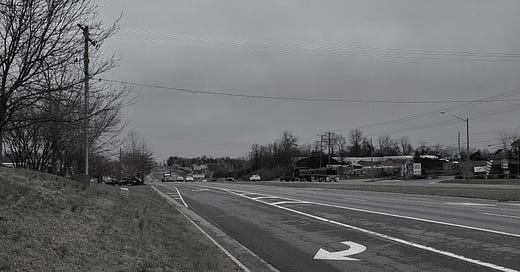I’ve written occasionally about the overlap between my ideas on urbanism, broadly understood, and my Catholic faith. A lot people arrive at urbanist conclusions through libertarianism or progressivism. I tend, personally, to arrive at them through a communitarianism influenced by the Catholic worldview.
The other day I was thinking about traffic safety, and the arguments over who bears responsibility for it. Do pedestrians just have to look where they’re going? Do motorists just have to pay full attention to the road? Do engineers just have to build safer road designs? Do we need more bike lanes, or to get rid of cyclists? (Some people seem to think that’s the solution.)
I tend towards viewing this as a design problem. When roads feel like speedways, you want to speed. The road itself, and the speed limit sign, are giving you conflicting signals as a motorist. The potential for speed, foreclosed by what feels like an artificial, arbitrary limit, produces a constant, gnawing frustration when you’re behind the wheel. Some people, I think, view taming that desire for speed as a virtue. I do, too. But that can’t be the whole solution.
This makes me think of a concept in Catholicism known as the “near occasion of sin.” I explained that idea in a different piece:
It is considered a sin not just to actually commit a sin, but even to put yourself in a situation where you know you will be tempted. Of course, you’re supposed to resist temptation, if you find yourself feeling it. But you’re not supposed to court it. Deliberately testing your willpower isn’t virtuous.
In other words, don’t fight the temptation (though do that); figure out a way to remove the temptation, or the circumstances which give rise to it. This isn’t “abdicating personal responsibility.” It’s just recognizing our susceptibility to temptation, our fallen nature. Building virtue isn’t like building muscle, constantly challenging yourself and bringing yourself right to your breaking point.
The problem with traffic safety, of course, is that there is no way for an individual motorist to stop subjecting himself to the “near occasion of speeding,” because the roads are built to induce that temptation. Bad design forces every single road user to chafe against their nature, all the time. It effectively outsources a problem of public interest—and an ever-present frustration, and a public safety disaster—onto every single individual.
I think there’s probably something very American about that skepticism towards public policy and public interest, and I think Catholic thought has always been more amenable to those concerns. (A couple of folks have noted there’s something sort of Buddhist in spirit here too: something like the understanding that negating, rather than fulfilling, desires can bring contentment.)
Have you ever had a thought like this? Leave a comment!
Related Reading:
Speeding and the Eucharistic Prayer
Asking For the Right Tool Isn’t Asking For a Handout
Thank you for reading! Please consider upgrading to a paid subscription to help support this newsletter. You’ll get a weekly subscribers-only post, plus full access to the archive: over 500 posts and growing. And you’ll help ensure more material like this!




Mostly just want to say kudos on tying this Catholic concept to speeding - very creative! Personally, the older I get (and the more car accidents I have been in), the less likely I am to be tempted to speed. I am getting to the point where I think many speed limits are too generous as I see the carnage on the roads. I agree better design would be good, and I have a longing for safer non-car forms of transportation that doesn't require cramming into Metro cars at rush hour (a miserable experience).
It's pretty well-known in other domains (and indeed in road design in other countries) that just asking people to try harder or pay closer attention is no substitute for better system design. Just think of aviation safety.
As to "urbanist conclusions", the crazy fact is they aren't more widespread. The old human-scale walkable neighborhoods of DC, Boston, and New York are expensive tourist hotspots, and companies build fake versions of Europe or Main Street to draw people to Disney World, Vegas, and Rodeo Drive. It's just proof that people tend to accept whatever they're given.